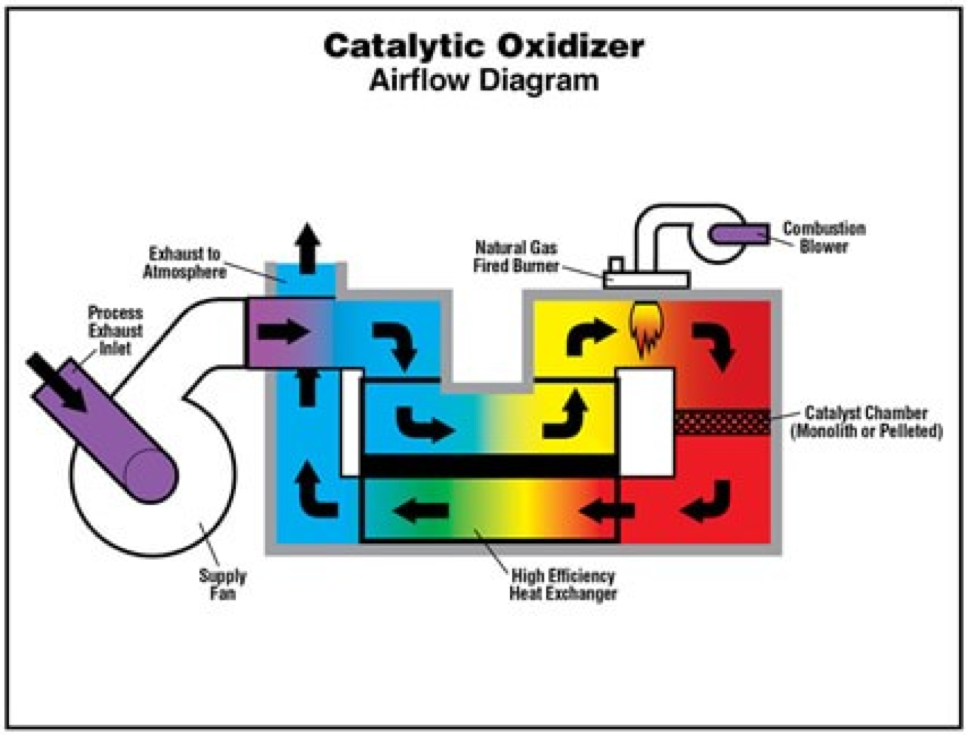The control of air pollutant emissions – such as VOCs, NOx, and SOx – is a costly process for manufacturers. Selecting and properly maintaining your air pollution abatement system will not only help you stay compliant with strict regulations but also lower your operating costs, reduce downtime, and increase efficiencies.
One of the most effective air pollution abatement solutions for the manufacturing industry is catalytic thermal oxidizers. Along with a proper maintenance plan, the equipment offers a cost-efficient solution to air pollutant emissions control.
How a Catalytic Oxidizer Works
Catalytic oxidizers use heat to break down harmful chemicals generated from manufacturing processes. With the aid of an industrial-grade catalyst, the chemical reaction can be carried out at lower temperatures compared to thermal oxidation.
Catalytic oxidizers utilize a high-efficiency counter-flow plate type heat exchanger in which air pollutants are mixed with oxygen and passed through a heated bed of precious metal catalyst. The pollutants in the air stream are converted into CO2, water, and heat.
The rate of the reaction can be adjusted by changing the temperature of the catalyst chamber and the contact time between the catalyst and the pollutants.

The Benefits of Catalytic Oxidizers
Catalytic oxidizers are highly energy-efficient. The use of a catalyst reduces the heat needed to reach the temperature required for the chemical reaction, significantly lowering the operating cost of the manufacturing plant.
The system boasts an air pollutant destruction efficiency of 99%. It’s easy to install and operate, and the maintenance cost is lower compared to many other air pollution abatement systems.
Catalytic oxidizers are most suitable for manufacturing processes that emit a low to moderate concentration of air pollutants, such as heat-set printing, flexographic printing, converting web dryers, chemical processes, etc.
Maximize the Performance of Your Catalytic Oxidizer with Proper Maintenance
Regular maintenance is the key to optimizing the cost-effectiveness of a catalytic oxidizer.
The operational efficiency of a catalytic oxidizer is determined by the effectiveness of the catalyst. A decrease in the temperature rise is often directly proportional to the drop in pollutant destruction.
Schedule annual catalyst testing to ensure that proper temperature increase is attained. A noticeable decrease in temperature rise, which often happens after 30,000 to 50,000 operating hours, often indicates the need to renew the catalyst.
However, if the temperature drops significantly when a catalyst is relatively fresh, you can perform the following maintenance operations:
- Burn-out: Remove carbon and organic matters accumulated on the surface of the catalyst.
- Air lancing: Remove the catalyst from the oxidizer manually and blow out dust from its surface with an air lance set under 80 psi.
- Chemical cleaning: If burn-out and air lancing don’t lead to significant improvement, then you can try chemical rejuvenation.
In addition, regularly inspect the stainless steel parts as they’re the most costly components in the system. Timely repairs can reduce the need to purchase large replacement parts.
An efficient catalytic oxidizer system, supported by proper maintenance, is the key to cost-effectively managing air pollutant emissions. Learn more about our catalytic oxidizer systems and how we can help you optimize your operations here.




